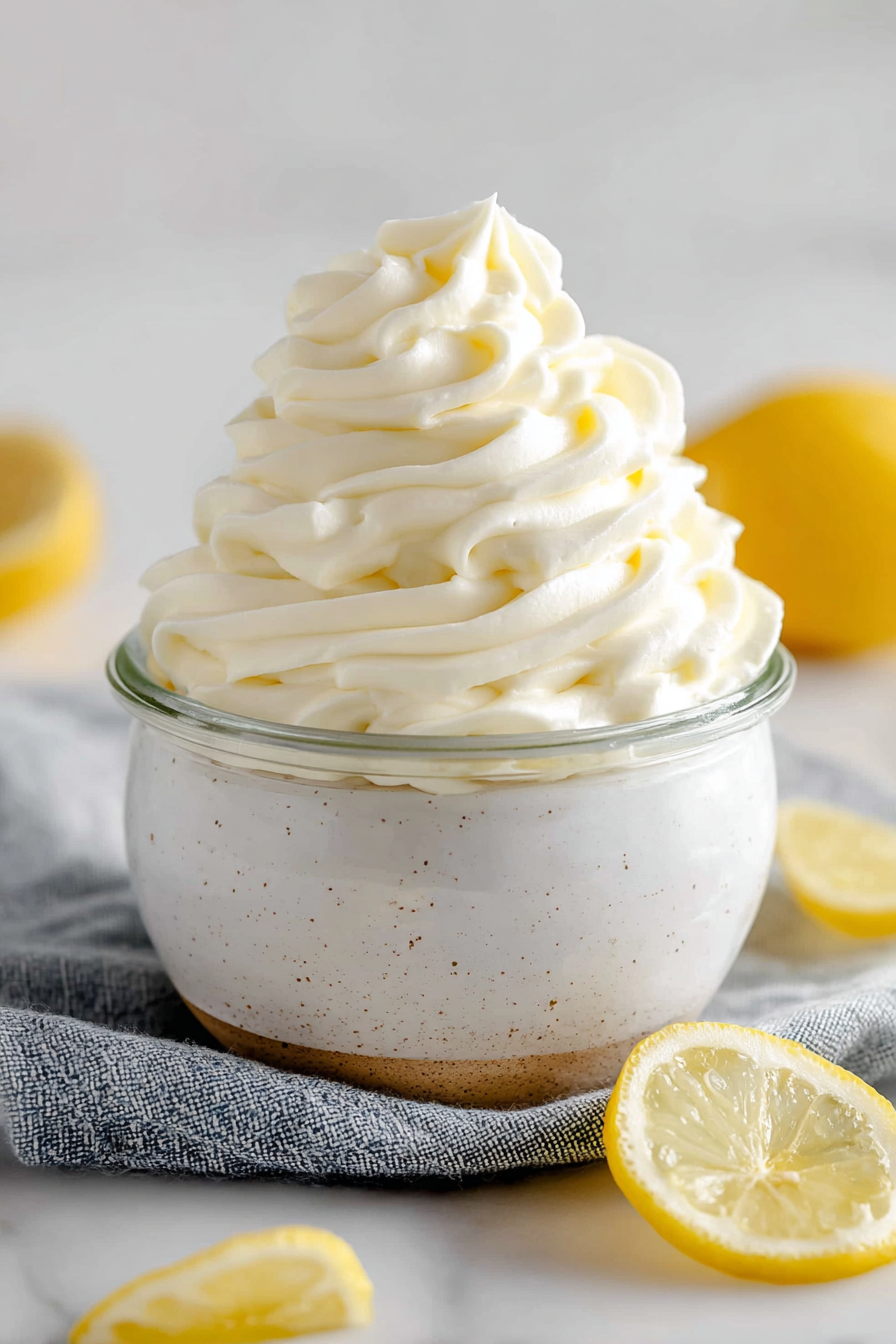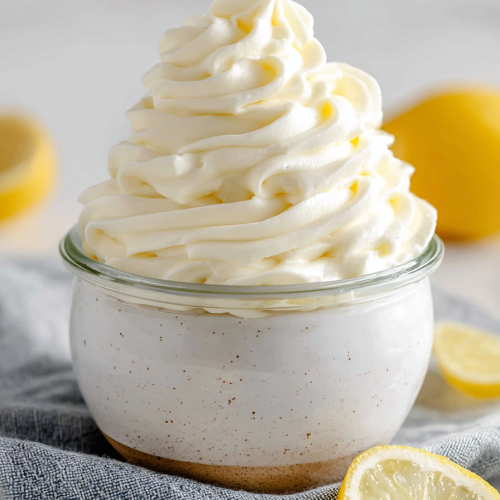Delish Lemon Ermine Frosting Recipes

This lemon ermine frosting is the soft, pillowy buttercream that tastes lighter than it looks — a classic boiled-milk (or flour-roux) frosting that’s creamier than a Swiss meringue and less sweet than American buttercream. Bright lemon zest and a splash of juice lift the whole thing, cutting through the richness and giving it a fresh, sunny finish. It’s especially right for layer cakes, lemon bars, or any dessert that needs a silky, not-too-sweet topping with real citrus character.
My husband calls this “the frosting that makes me forgive cake crumbs on the couch.” It’s become our weekend ritual: I bake a simple lemon cake, he insists on a thick swipe of ermine, and the kids stage a nosy-plate attack while I’m setting the final layer. I remember the first time I tried it — I was intimidated by the stove-top step — but once I had a bowl of that glossy, whipped frosting, it felt like discovering a new favorite sweater: unexpectedly comfortable and somehow elevated everything I put it on.
Why You’ll Love This Delish Lemon Ermine Frosting Recipes
– It’s luxuriously smooth but not cloying — the cooked milk base gives body without heavy sweetness.
– Lemon brightens every bite, making desserts feel lighter and more balanced than big butter-only frostings.
– It holds shape well for spreading and piping once chilled, so it’s practical for layer cakes and decorative touches.
– It’s forgiving: if your roux cools too much or seems loose, gentle warming and a good whip bring it back.
Behind the Recipe
Ermine frosting is essentially a cooked flour-and-milk paste that, when chilled and whipped with butter and sugar, becomes a fluffy, almost mousse-like buttercream. The key is patience: let the cooked base cool completely so the butter doesn’t melt when you whip it, and use room-temperature butter so it incorporates into glossy peaks. People trip up by rushing the cooling step or adding cold butter, which can make the frosting grainy or greasy. Little touches that lift it: fresh lemon zest (not just juice) for perfume, a tiny pinch of salt to brighten the flavors, and a light icing sugar dusting at the end if you want extra sweetness without changing texture.
Shopping Tips
– Baking Basics (Flour/Sugar/Leaveners): Use all-purpose flour for the cooked base — it thickens predictably and gives the right texture; superfine confectioners’ sugar makes for a smoother whip.
– Dairy: Whole milk is best for richness; swap to 2% only if you prefer a slightly lighter result, but skim won’t give the same body.
– Eggs: This version doesn’t rely on raw egg whites, but if you’re following a variation that does, buy pasteurized eggs for safety.
– Citrus: Choose unwaxed lemons for the brightest zest; if only waxed are available, scrub and dry well before zesting.
– Sweeteners: Confectioners’ sugar gives structure and smoothness; you can reduce it modestly, but large cuts will change mouthfeel and stability.
Prep Ahead Ideas
– Make the cooked flour-and-milk base a day ahead and refrigerate it covered; whip with butter the next day for a very stable, well-developed texture.
– Zest lemons and measure sugar into containers the day before to speed assembly. Keep prepped components in airtight tubs — the base will keep 3–4 days in the fridge.
– Pre-bake cake layers and freeze between parchment sheets; thaw in the fridge overnight before frosting for a stress-free build day.
Time-Saving Tricks
– Whisk the roux on a single burner while you measure and zest to keep things moving — one-pan mindset reduces cleanup.
– Use a stand mixer for the final whipping; it aerates faster and frees your hands for other tasks.
– If you’re short on time, warm the cooled base briefly in a simmering water bath to loosen it before whipping, but don’t overheat — you want it cool, not hot.
Common Mistakes
– Overheating the roux: I once boiled the milk mixture too long and the paste tightened into lumps; strain it through a fine-mesh sieve and whisk vigorously to smooth.
– Adding butter when the base is still warm: this can make the frosting greasy — chill the base until lukewarm or cool, then add softened butter.
– Trying to cut sugar drastically: ermine relies on powdered sugar for stability; if you cut too much, the frosting won’t hold peaks. Rescue it by chilling briefly, then re-whipping with a few tablespoons of sifted powdered sugar.
What to Serve It With
This frosting is fantastic on a light lemon layer cake, vanilla sponge, or as the finishing touch on lemon cupcakes. It’s also a lovely partner for berry desserts — especially strawberries or raspberries — and provides a bright contrast to denser cakes like pound cake or olive oil cake.
Tips & Mistakes
For the cleanest texture, strain the cooked flour base before chilling to remove any small lumps. If your frosting breaks (appears curdled or separated), chill it briefly, then re-whip at medium speed; adding a tablespoon or two of cold cream or more powdered sugar can coax it back together. Don’t skip the salt — even a pinch elevates the lemon and balances sweetness.
Storage Tips
Store in airtight containers in the fridge. It reheats beautifully, but if you sneak a bite cold straight from the container, it still works.
Variations and Substitutions
– For a lime or orange twist, swap the lemon zest and juice in equal measure — lime gives a slightly sharper profile, orange mellows it.
– To make it dairy-free, try a neutral-tasting vegan butter and full-fat oat or soy milk for the roux; the texture will be slightly different but still very pleasant.
– If you want a tangier frosting, fold in a small amount of cream cheese (use chilled, softened cream cheese and expect a denser finish); the classic ermine is worth keeping for its lightness.

Write me the frequently asked questions and answers Delish Lemon Ermine Frosting Recipes in the same way as the example below.
Frequently Asked Questions

Delish Lemon Ermine Frosting Recipes
Ingredients
Main Ingredients
- 1 cup whole milk Use fresh milk for the best flavor.
- 1 cup granulated sugar
- 0.5 cup unsalted butter Softened to room temperature.
- 0.5 cup all-purpose flour
- 2 tsp vanilla extract Use pure vanilla for optimal flavor.
- 2 tbsp lemon juice Freshly squeezed is best.
- 1 tbsp lemon zest Make sure to zest finely.
Instructions
Preparation Steps
- In a saucepan, combine the milk, sugar, and flour. Whisk together over medium heat until it thickens and begins to bubble. This should take about 5-7 minutes. Stir continuously to prevent burning.
- Remove the saucepan from heat and allow the mixture to cool slightly. Once cooled, stir in the butter, vanilla extract, lemon juice, and lemon zest until everything is well incorporated and creamy.
- For a fluffier texture, beat the frosting with an electric mixer for a few minutes after mixing all ingredients. This will add air and increase the creaminess.
- Spread the frosting generously onto your cooled cakes or cupcakes, and enjoy the delightful lemon flavor!
